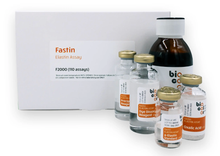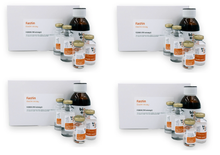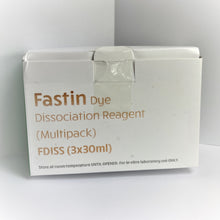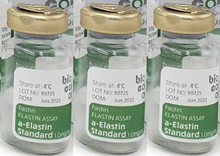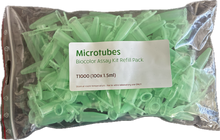
Introducing the Fastin Assay Kit: Your Straightforward Solution for Elastin Quantification! Our user-friendly kit utilizes a dye-based method to measure elastin from in-vivo and in-vitro sources. It can be used to quantify various elastin forms, spanning from immature tropoelastin to mature, 'insoluble' elastin fibers.
Description
The Biocolor Fastin™ Elastin Assay is a quantitative dye-binding method for the analysis of elastins released into tissue culture medium and extracted from biological materials.
The dye label employed is 5,10,15,20-tetraphenyl-21H,23H-porphine tetra-sulfonate (TPPS).
Elastin forms that can be measured by the Fastin Assay as α-elastin:
- soluble tropoelastins;
- lathyrogenic elastins;
- insoluble elastins (following solubilization to elastin polypeptides [α-elastin, κ-elastin])
The dye reagent binds to the ‘basic’ and ‘non-polar’ amino acid sequences found in mammalian elastins. For analysis of soluble elastin, samples should be free of any particulate material (cell debris, insoluble extracellular matrix material). The presence of other soluble proteins or of complex carbohydrates does not interfere with the Fastin Elastin Assay.
Principle of Method
Step 1. Incubation of samples containing soluble elastin with the Fastin Dye Reagent causes an elastin-dye complex to form. This insoluble complex then precipitates.
Step 2. Dye-labelled elastin is then isolated by centrifugation and the unbound dye removed. Elastin-bound dye is then eluted and measured spectrophotometrically.
Step 3. The elastin content of unknown samples can be calculated by comparison against a calibration curve prepared using a standard comprising water-soluble elastin (supplied with the kit).

Suitable Samples
In-vivo: tissues and fluids. Insoluble elastin will first require conversion to water soluble α-elastin using the oxalic acid reagents and extraction protocol supplied with the kit.
In-vitro: Elastin produced by cells during 2D/3D cell culture. NB elastin in conditioned cell media is typically below the detection limit of the kit.
Specifications
| Product Category: | |
| Detection Method: | Colorimetric Detection (513 nm) |
| Assay Range: | 0 - 500 µg/ml |
| Limit of Detection: | 50 µg/ml |
| Assay Run-Time: | 4 hours |
| Measurements Per Kit: | 110 in total (allows a maximum of 48 samples to be run in duplicate alongside a standard curve) |
| Storage (unopened kit): | Room Temperature (RT) |
| Manufacturer: | Biocolor Ltd. |
| Country of Origin: | United Kingdom |
Kit Contents
The standard size Fastin™ Elastin kit (cat. no. F2000) contains:
- Dye Reagent (1x110ml)
- α-elastin Reference Standard (1x5ml, 1.0 mg/ml soluble Bovine elastin)
- Oxalic Acid (1x20ml)
- Precipitating Reagent (1x30ml)
- Dye Dissociation Reagent (1x30ml)
- 1.5 ml micro-centrifuge tubes for dye-labelling reaction.
- Assay kit manual
Other Names/Synonyms
soluble tropoelastins, lathyrogenic elastins, Fastin Elastin
Resources
- Product Datasheet (PDS)
- Material Safety Data Sheet (MSDS)
- Frequently Asked Question (FAQ)
- Product References (Extended)
2025 Product References
- Song, Minwoo et al. “A Hierarchical Short Microneedle-Cupping Dual-Amplified Patch Enables Accelerated, Uniform, Pain-Free Transdermal Delivery of Extracellular Vesicles.” Nano-micro letters vol. 18,1 11. 23 Jul. 2025, doi:10.1007/s40820-025-01853-7
- Zhao, Wenshan et al. “Fibulin-1 deficiency alleviates liver fibrosis by inhibiting hepatic stellate cell activation via the p38 MAPK pathway.” Cellular and molecular life sciences : CMLS vol. 82,1 192. 5 May. 2025, doi:10.1007/s00018-025-05647-3
- Hussein, Kamal H et al. “Efficacy of xenogeneic fresh and lyophilized amniotic membranes on the healing of experimentally induced full-thickness skin wounds in dogs.” Scientific reports vol. 15,1 15605. 4 May. 2025, doi:10.1038/s41598-025-95023-9
- Singh, Pragya et al. “Comparative Study of Placental Allografts with Distinct Layer Composition.” International journal of molecular sciences vol. 26,7 3406. 5 Apr. 2025, doi:10.3390/ijms26073406
- McCarthy, Michelle E et al. “Decellularization of Human Digits: A Step Towards Off-the-Shelf Composite Allograft Transplantation.” Bioengineering (Basel, Switzerland) vol. 12,4 383. 3 Apr. 2025, doi:10.3390/bioengineering12040383
- De Miguel-Gómez, Lucía et al. “Toward human uterus tissue engineering: Uterine decellularization in a non-human primate species.” Acta obstetricia et gynecologica Scandinavica vol. 104,3 (2025): 483-493. doi:10.1111/aogs.15030
- Costa, E et al. “Role of Myofibroblasts in the Repair of Iatrogenic Preterm Membranes Subjected to Mechanical Stimulation.” Prenatal diagnosis vol. 45,1 (2025): 102-112. doi:10.1002/pd.6722
Usage
This product is intended for laboratory research use only and is not for use in diagnostic procedures.
Background
Understanding Elastin: The Key to Tissue Flexibility:
Tissues such as lungs, heart and blood vessels need to be able to stretch and recoil repeatedly throughout an organism's life. The protein Elastin is largely responsible for this elasticity. Elastin is initially secreted by elastin-producing cells as a soluble monomeric precursor known as tropoelastin. This undergoes a process of self-assembly and cross-linking with other extracellular matrix components that results in the formation of "insoluble" elastin fibers.
Ilex Life Sciences LLC is an official distributor of Biocolor products.







